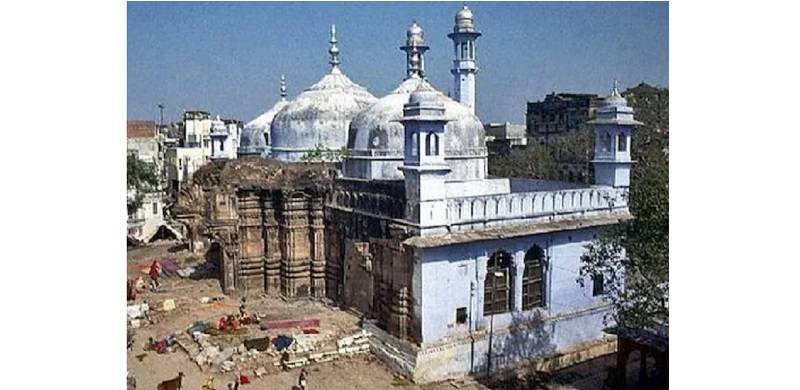
In an India that gives an increasingly dystopian appearance, a storm of communal upheaval is gusting towards the Muslim community, particularly their sites of worship, many of which are linked to significant historical events.
In 2021, five Delhi-based women petitioned a local court for permission to worship Hindu deities such as Maa Shringar Gauri, Lord Ganesh, Lord Hanuman and Nandi (a bull mount of Lord Shiva), statues of which were purportedly discovered atop the Gyanvapi Mosque's outside wall and elsewhere within the complex. Gyanvapi Mosque, a 17th-century mosque standing adjacent to Kashi Vishwanath temple, was erected by Mughal emperor Aurangzeb in 1669 in Varanasi (known as Banaras), northern India.
On 26 April 2022, a Varanasi court issued a contentious decision allowing a video-recorded survey of the mosque. A stone shaft, a Shivling, a relic of Hindu god Shiva, was discovered in the mosque's ablution water tank, as well as other Hindu symbols, according to the assessment. The Anjuman Intezamia Masajid Management Committee (AIMMC), a Muslim organisation that oversees several mosques, including Gyanvapi, has filed a lawsuit against the Varanasi court's decision, claiming that the alleged artefact discovered during the inspection is actually part of a fountain in the ablution water tank.
The court then shut a section of the mosque without giving the mosque management a chance to submit their argument. The case has now reached the Supreme Court, which ruled on 17 May 2022 that the complex would be safeguarded and that prayers at the mosque will continue. This has sparked worries of a repeat of the decades-long battle over the Babri Masjid that was demolished to the ground by Hindu rioters in 1992 in Ayodhya.
The Places of Worship Act (Special Provisions Act), passed in 1991 in response to the politicisation of the Babri Masjid - Ram Janma Bhoomi dispute at the time, under section 3 prohibits the conversion of a place of worship of one sect into another and preserves its religious character as it existed on 15 August 1947 (India's Independence Day from British rule). However, section 5 explicitly exempts the Babri Masjid issue from these prohibitions. Video examination of Gyanvapi mosque and Hindu organisations’ claim to it, according to Indian Muslims, is a violation of the 1991 ordinance.
Prominent Muslim leader Asaduddin Owaisi claimed that the Babri Masjid was taken away from Muslims by deception and injustice, but that Muslims will not lose another mosque. Hindu right-wing organisations, with the cooperation of the Ayodhya district administration, installed Hindu idols in the Babri Mosque on a chilly December night in 1949, igniting a conflict about Ram's birthplace that launched the Bharatiya Janata Party (BJP) into political prominence in the 1980s, in Owaisi’s view. He compared the occurrences at the Gyanvapi Mosque to the events at the Babri Mosque seven decades earlier.
In 1991, the legal and historical controversy regarding the origins of the Gyanvapi mosque entered India's legal hallway. Priests filed applications in Varanasi's Civil Court to worship inside the mosque. They said that the mosque was built on top of a section of the Kashi Vishwanath temple that had been dismantled. The proceedings were stayed by the Allahabad High Court in 1998, when Gyanvapi mosque's Management Committee opposed these early petitions by jogging their memory that courts are enclosed with the 1991 Act. After the Supreme Court's decision in the Babri Masjid dispute in 2019, the Gyanvapi issue was resurrected in December 2019 after remaining pending for 22 years.
“Ayodhya tou sirf jhanki hai, Kashi, Mathura baki hai” (Ayodhya is only a teaser; Kashi and Mathura remain) – Hindu right-wing activists have pledged to “liberate” the trio of sites by destroying Islamic buildings as evidenced by the slogan.
In recent weeks, after Ayodhya, the Hindu supremacist movement has expanded their assault against major Muslim historical landmarks, including the Gyanvapi mosque in Varanasi, Taj Mahal in Agra, Qutub Minar in New Delhi and Shahi Idgah Masjid in Mathura. They stated that all of the structures, including the mosque, were constructed after Hindu temples were demolished!
A Hindu man in Mathura, Uttar Pradesh, submitted a petition on 13 May 2022 asking the court to investigate the presence of Lord Krishna relics and old religious inscriptions on the premises of the Shahi Idgah Mosque. According to reports, Hindu organisations filed fresh applications in the Mathura court on 18 May to halt Muslim access to the mosque.
On 12 May 2022, the Allahabad High Court in Uttar Pradesh denied a plea submitted by Dr Rajneesh Singh, a BJP media in-charge, that sought to organise a “fact-finding committee” to uncover 22 “hidden rooms” in the Taj Mahal's basement in order to learn the “true history” of one of the world's Seven Wonders. According to the appeal, the Taj Mahal was once a Shiva temple known as “Tejo Mahalaya” until the Mughals transformed it into a tomb.
India has about 200 million Muslims, an immense minority population. Thus far, they encounter violence, bigotry and discrimination since independence, despite constitutional guarantees. Anti-Muslim prejudice has fueled the Hindutva movement (Hindu supremacist movement), designed to disenfranchise Muslims and to erase Muslims’ cultural legacy so as to establish Hindu dominance in India.
This ideology sends the message to Indian Muslims that they should only be Muslims in their own homes, and that once they leave, they must submit to Hindutva.
In 2021, five Delhi-based women petitioned a local court for permission to worship Hindu deities such as Maa Shringar Gauri, Lord Ganesh, Lord Hanuman and Nandi (a bull mount of Lord Shiva), statues of which were purportedly discovered atop the Gyanvapi Mosque's outside wall and elsewhere within the complex. Gyanvapi Mosque, a 17th-century mosque standing adjacent to Kashi Vishwanath temple, was erected by Mughal emperor Aurangzeb in 1669 in Varanasi (known as Banaras), northern India.
On 26 April 2022, a Varanasi court issued a contentious decision allowing a video-recorded survey of the mosque. A stone shaft, a Shivling, a relic of Hindu god Shiva, was discovered in the mosque's ablution water tank, as well as other Hindu symbols, according to the assessment. The Anjuman Intezamia Masajid Management Committee (AIMMC), a Muslim organisation that oversees several mosques, including Gyanvapi, has filed a lawsuit against the Varanasi court's decision, claiming that the alleged artefact discovered during the inspection is actually part of a fountain in the ablution water tank.
The court then shut a section of the mosque without giving the mosque management a chance to submit their argument. The case has now reached the Supreme Court, which ruled on 17 May 2022 that the complex would be safeguarded and that prayers at the mosque will continue. This has sparked worries of a repeat of the decades-long battle over the Babri Masjid that was demolished to the ground by Hindu rioters in 1992 in Ayodhya.
The Places of Worship Act (Special Provisions Act), passed in 1991 in response to the politicisation of the Babri Masjid - Ram Janma Bhoomi dispute at the time, under section 3 prohibits the conversion of a place of worship of one sect into another and preserves its religious character as it existed on 15 August 1947 (India's Independence Day from British rule). However, section 5 explicitly exempts the Babri Masjid issue from these prohibitions. Video examination of Gyanvapi mosque and Hindu organisations’ claim to it, according to Indian Muslims, is a violation of the 1991 ordinance.
Prominent Muslim leader Asaduddin Owaisi claimed that the Babri Masjid was taken away from Muslims by deception and injustice, but that Muslims will not lose another mosque. Hindu right-wing organisations, with the cooperation of the Ayodhya district administration, installed Hindu idols in the Babri Mosque on a chilly December night in 1949, igniting a conflict about Ram's birthplace that launched the Bharatiya Janata Party (BJP) into political prominence in the 1980s, in Owaisi’s view. He compared the occurrences at the Gyanvapi Mosque to the events at the Babri Mosque seven decades earlier.
In 1991, the legal and historical controversy regarding the origins of the Gyanvapi mosque entered India's legal hallway. Priests filed applications in Varanasi's Civil Court to worship inside the mosque. They said that the mosque was built on top of a section of the Kashi Vishwanath temple that had been dismantled. The proceedings were stayed by the Allahabad High Court in 1998, when Gyanvapi mosque's Management Committee opposed these early petitions by jogging their memory that courts are enclosed with the 1991 Act. After the Supreme Court's decision in the Babri Masjid dispute in 2019, the Gyanvapi issue was resurrected in December 2019 after remaining pending for 22 years.
“Ayodhya tou sirf jhanki hai, Kashi, Mathura baki hai” (Ayodhya is only a teaser; Kashi and Mathura remain) – Hindu right-wing activists have pledged to “liberate” the trio of sites by destroying Islamic buildings as evidenced by the slogan.
In recent weeks, after Ayodhya, the Hindu supremacist movement has expanded their assault against major Muslim historical landmarks, including the Gyanvapi mosque in Varanasi, Taj Mahal in Agra, Qutub Minar in New Delhi and Shahi Idgah Masjid in Mathura. They stated that all of the structures, including the mosque, were constructed after Hindu temples were demolished!
A Hindu man in Mathura, Uttar Pradesh, submitted a petition on 13 May 2022 asking the court to investigate the presence of Lord Krishna relics and old religious inscriptions on the premises of the Shahi Idgah Mosque. According to reports, Hindu organisations filed fresh applications in the Mathura court on 18 May to halt Muslim access to the mosque.
On 12 May 2022, the Allahabad High Court in Uttar Pradesh denied a plea submitted by Dr Rajneesh Singh, a BJP media in-charge, that sought to organise a “fact-finding committee” to uncover 22 “hidden rooms” in the Taj Mahal's basement in order to learn the “true history” of one of the world's Seven Wonders. According to the appeal, the Taj Mahal was once a Shiva temple known as “Tejo Mahalaya” until the Mughals transformed it into a tomb.
India has about 200 million Muslims, an immense minority population. Thus far, they encounter violence, bigotry and discrimination since independence, despite constitutional guarantees. Anti-Muslim prejudice has fueled the Hindutva movement (Hindu supremacist movement), designed to disenfranchise Muslims and to erase Muslims’ cultural legacy so as to establish Hindu dominance in India.
This ideology sends the message to Indian Muslims that they should only be Muslims in their own homes, and that once they leave, they must submit to Hindutva.

